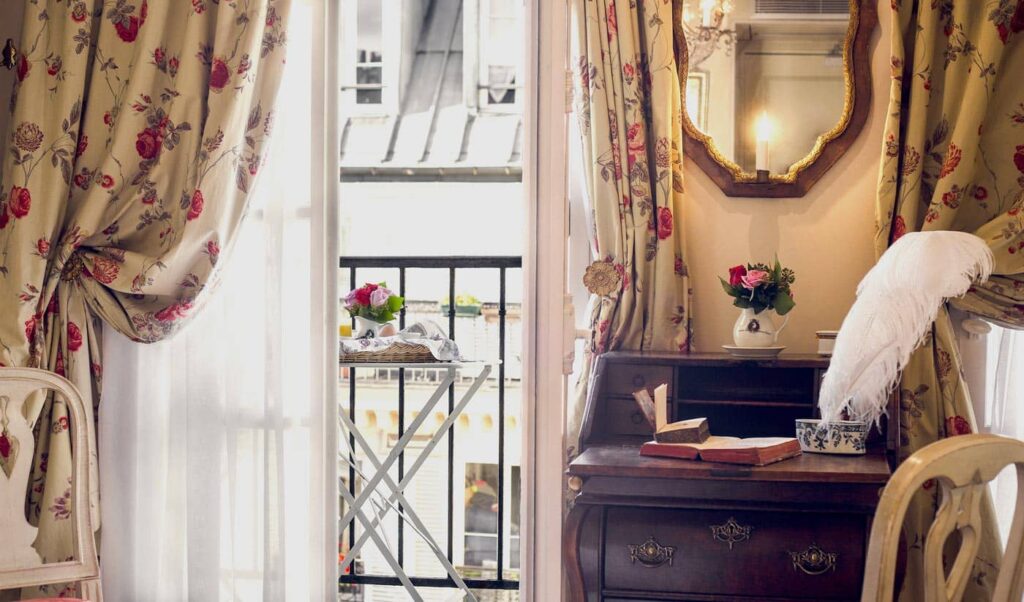Opened in March 1993, the hotel was conceived as an homage to Beaumarchais (1732-1799) and his period. The occasion to remind that the well known play writer created his main works, in the Marais, 2 steps from the hotel at number 47, rue Vieille du Temple. His house perfectly conserved has been recently renovated.
The decor of the hotel
The quest for authentic and significant objects and documents has orientated the entire evolution of the hotel and its décor.
During the preliminary installation works, the discovery of a first edition of the Marriage of Figaro, Beaumarchais’s most famous play, inspired the initial decoration of the rooms. The poor state of the book’s binding enabled the pages to be separated and integrated in each room under frames displaying a montage of handwritten letters, book engravings, deeds, a whole batch of original 18th-century documents bought from a dealer in ancient documents from Lyon.
As the years went by, original pieces, mostly 18th-century furniture and objects, replaced the copies and completed the décor. Fifteen years of searching without really looking, since the pieces seemed to come to us. The card table, the piano forte, the harp, the sculpture, the chandelier in the reception, the two lanterns in the bay windows – need one mention them all?- the most significant pieces appeared before us, obvious. Haphazardly, at the turn of a corner, they imposed themselves of their own will: the card table in an antique dealer’s shop window close to Hôtel Drouot, some pieces at the flea market, and most of them in Paris, in our neighbourhood, the Marais, the Marché Saint Paul or on Ile Saint-Louis.
The 2 hotel’s renovations
The hotel’s two renovations were important moments, catalysers. That of 2004-2005 saw the renewal of the rooms’ décor and that of 2008, which also included overall painting and roof-repair works, when the lobby was completely redecorated. Two important dates that each brought with them a moment of reflection and sparked off the discovery of new elements.
In 2004-2005, in the rooms, to set off the complete renewal of the upholstery and the fitted carpets, the rooms’ décor was metamorphosed not only by adding chandeliers and mirrors, but also antique writing-desks, sloped desks and “Bonheurs du Jour”.
In 2007, as a forerunner to the renovation of the reception, came the turn of the lift and the breakfast lounge to be redecorated. And it was the choice of fabric furbishing the reception in 2008, a moiré fabric with rose foliage, which introduced the second important phase. This fabric produced according to an original Louis XV document, contrasts with the previous fabric (a Louis XVI striped brocade) and heralds in a second metamorphosis. One goes back in time to the period of Louis XV. A gayer context in the history of art: fresher, more colourful. A context in which the arts are dominated by women, not least by Madame de Pompadour, whose portrait, moreover, introduces the hotel’s website, created in 2005. A happy period when Paris gave the tone to the whole world, consecrating French art as an inescapable reference of good taste and the art of living, lasting even to the present day.
A décor that was freer, more daring in the relations of form and colour, harder to bring off and which I would never have envisaged in 1993: fifteen years of experience enabling me to dare the audacities and liberties of Louis XV’s style.
What is a décor?
That is the question. The acquisition of antique pieces during the last fifteen years has provided me with an answer: it is the works themselves that become essential, they that come to one, as I have tried to explain above. These works become crucial to the places that receive them, they create the relations, establish the décor. It is quite the contrary of decoration, which places the objects, the furniture, the works of art based on an architectural plan, according to a preconceived idea. I have attempted something quite different: to suggest a whole through the significant presence of beautiful things, that is to say forceful and evocative objects, pieces of furniture or paintings, which are capable of drawing the eye first by their very presence and of creating relations. What the Italians call “ambiente”, a term that cannot be translated and that the word “atmosphere” falls short of describing.
These juxtapositions, this “ambiente”, that is what represents a décor. Far from decoration, it is a sensitive experience that involves relating works and objects to each other through time; it is a life experience and not just the creation of a scenario for the pleasure of the eyes.
These works, reorganized here in a context that serves as a kind of coherence (in our case, Beaumarchais, the Marais, the 18th Century and French art), can in this way speak to us more meaningfully of the past. They address us in the present tense and help us get a better feeling for what Paris and our country’s culture represents, in particular for what the 18th Century has contributed, what it means to us nowadays.
The past is not totally past if it enriches us and makes us more creative. It is in this sense that a décor can become a life experience. And all that this hotel aims to achieve, besides the comfort and well-being of its guests, is to communicate this feeling and experience to both french and foreign visitors during their stay.
